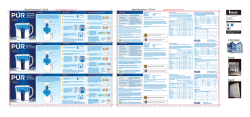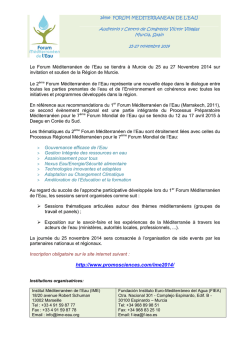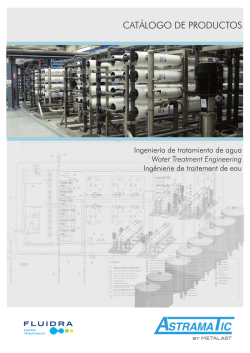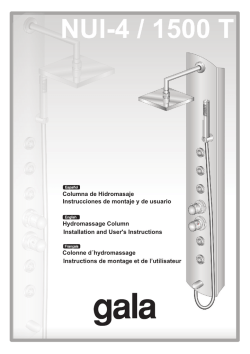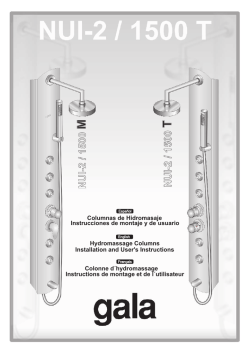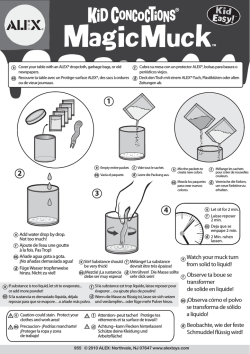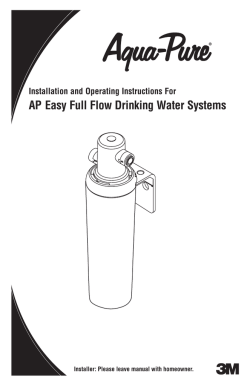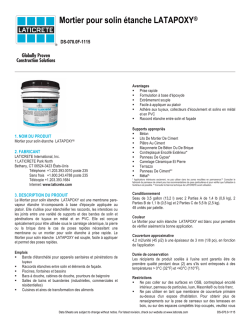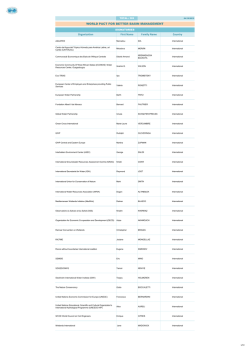
NSF PERFORMANCE DATA SHEET
NSF PERFORMANCE DATA SHEET The eSpring® Carbon Water Treatment System is listed with the NSF International. NSF International is an independent testing and certification agency established to set quality standards for a wide variety of home and industrial products. Many regulatory agencies, municipal water treatment officials and residential builders look for NSF International listing as certification that a product will meet high performance standards. The following product information is presented in compliance with NSF International disclosure requirements. eSpring Carbon Water Treatment System No.: CXV3708 Replaceable Filter No.: 11-0194 The eSpring Carbon Water Treatment System is comprised of a compressed activated carbon block filter for mechanical and chemical filtration. This Carbon Water Treatment System has been tested according to NSF/ANSI 42 and 53 for reduction of the substances listed below. The concentration of the indicated substances in water entering the system was reduced to a concentration less than or equal to the permissible limit for water leaving the system as specified in NSF/ANSI 42 and 53. Substance Influent Challenge Concentration Reduction Requirements/ Max. Permissible Product Water Concentration % Reduction NSF/ANSI Standard 42 Aesthetic Effects Particulates-Class I (#/mL at 0.5 to <1 micron) Chlorine Taste and Odor (mg/L as chlorine) Chloramine (mg/L) Asbestos (fibers/mL >10 µm) Lead at pH 6.5 (µg/L) Lead at pH 8.5 (µg/L) Mercury at pH 6.5 (µg/L) Mercury at pH 8.5 (µg/L) Alachlor (µg/L) Atrazine (µg/L) Benzene (µg/L) Carbofuran (µg/L) Carbon Tetrachloride (µg/L) Chlordane (µg/L) Chlorobenzene (µg/L) 2-4-D (µg/l) Dibromochloropropane (µg/L) o-Dichlorobenzene (µg/L) Endrin (µg/L) Ethylbenzene (µg/L) Ethylene dibromide (µg/L) Heptachlor (µg/L) Heptachlor epoxide (µg/L) Lindane (µg/L) Methyl-tert-butyl ether (MTBE) (µg/L) Methoxychlor (µg/L) PCBs (Aroclor 1260) (µg/L) Radon (pCi/L) Simazine (µg/L) Styrene (µg/L) Tetrachloroehthylene (µg/L) Toluene (µg/L) Total Trihalomethanes (TTHMs as chloroform) (µg/L) Toxaphene (µg/L) 2,4,5 TP (Silvex) (µg/L) Trichloroethylene (µg/L) †VOC’s (µg/L) as chloroform >10,000 2 ± 10% 3 ± 10% NSF/ANSI Standard 53 Health Effects 104-105 150 ± 10% 150 ± 10% 6.0 ± 10% 6.0 ± 10% 40 ± 10% 9 ± 10% 15 ± 10% 80 ± 10% 15 ± 10% 40 ± 10% 2000 ± 10% 210 ± 10% 4 ± 10% 1800 ± 10% 6 ± 10% 2100 ± 10% 1 ± 10% 80 ± 10% 4 ± 10% 2 ± 10% 15 ± 10% 120 ± 10% 10 ± 10% 4000 ± 25% 12 ± 10% 2000 ± 10% 15 ± 10% 3000 ± 10% 450 ± 20% 15 ± 10% 150 ± 10% 300 ± 10% 300 ± 10% >85% >95 ≥50% 0.5 >95 >95 >99% 10 10 2.0 2.0 2.0 3.0 5.0 40 5.0 2.0 100 70.0 0.20 600 2.0 700 0.05 0.4 0.20 0.20 5.0 40.0 0.5 300 4 100 5 1000 >95 >95 >95 >90 >90 >95 >90 >95 >95 >95 >95 >95 >95 >95 >95 >95 >95 >95 >95 >95 >95 >95 >95 >95 >95 >95 >95 >95 >95 80.0 3.0 50.0 5 95% >95 >90 >95 >95 >95 Test Conditions: pH: 7.75, Pressure: 60 p.s.i. (415 kPa), Flow Rate: 0.9 gal. (3.4 L) / min. †The following table sets forth allowable claims which can be made for drinking water treatment units that have met the requirements for VOC reduction. Organic Chemicals Included By Surrogate Testing Substance Alachlor Atrazine Benzene Carbofuran Carbon tetrachloride Chlorobenzene Chloropicrin 2,4-D Dibromochloropropane (DBCP) o-Dichlorobenzene p-Dichlorobenzene 1,2-Dichloroethane 1,1-Dichloroethylene cis-1,2-Dichloroethylene trans-1,2-Dichloroethylene 1,2-Dichloropropane cis-1,3-Dichloropropylene Dinoseb Endrin Ethylbenzene Ethylene dibromide (EDB) Haloacetonitriles (HAN): bromochloroacetonitrile dibromoacetonitrile dichloroacetonitrile trichloroacetonitrile Haloketones (HK): 1,1-dichloro-2-propanone 1,1,1-trichloro-2-propanone Heptachlor Heptachlor epoxide Hexachlorobutadiene Hexachlorocyclopentadiene Lindane Methoxychlor Pentachlorophenol Simazine Styrene 1,1,2,2-Tetrachloroethane Tetrachloroethylene Toluene 2,4,5-TP (Silvex) Tribromoacetic acid 1,2,4-Trichlorobenzene 1,1,1-Trichloroethane 1,1,2-Trichloroethane Trichloroethylene Trihalomethanes includes: Chloroform (surrogate chemical) Bromoform Bromodichloromethane Chlorodibromomethane Xylenes (total) Influent Challenge Level (ppb) Maximum Effluent Level (ppb) 50 100 81 190 78 77 15 110 52 80 40 88 83 170 86 80 79 170 53 88 44 1.0 3.0 1.0 1.0 1.8 1.0 0.2 1.7 0.02 1.0 1.0 4.8 1.0 0.5 1.0 1.0 1.0 0.2 0.59 1.0 0.02 22 24 9.6 15 0.5 0.6 0.2 0.3 7.2 8.2 250 10.7 44 60 55 50 96 120 150 81 81 78 270 42 160 84 150 180 0.1 0.3 0.01 0.2 1.0 0.002 0.01 0.1 1.0 4.0 0.5 1.0 1.0 1.0 1.6 1.0 0.5 4.6 0.5 1.0 300 70 15 1.0 In addition, NSF International has verified the water treatment claims for this model for the reduction of specific substances which are not included in NSF/ANSI Standard 53 or Standard 42 as follows: Additional Contaminants Additional Contaminants EPA Priority Pollutants Chemical % Reduction Influent Concentration Effluent (µg/L) Concentration (µg/l) EPA Priority Pollutants Acenaphthene Acenaphthylene Aldrin Anthracene Benzidine Benzo[a]anthracene Benzo[a]pyrene Benzo[b]fluoranthene Benzo[g,h,i]perylene Benzo[k]fluoranthene alpha-BHC beta-BHC delta-BHC gamma-BHC Bis(2-Chloroethoxy) methane Bis(2-chloroethyl) ether Bis(2-chloroisopropyl) ether Bis(2-ethyl-hexyl) phthalate 4-Bromophenyl phenyl ether Butyl benzyl phthalate 4-Chloro-3-methylphenol 2-Chloroethyl vinyl ether 2-Chlorophenol 4-Chlorophenyl phenyl ether Chrysene 4,4’-DDD Di-n-butyl phthalate Di-n-octyl phthalate Dibenzo[a,h]anthracene 1,3-Dichlorobenzene 3,3’-Dichlorobenzidine 2,4-Dichlorophenol trans-1,3-Dichloropropene Dieldrin Diethyl phthalate Dimethyl phthalate 2,4-Dimethylphenol 4,6-Dinitro-2-methyl phenol 2,4-Dinitrotoluene 2,6-Dinitrotoluene 1,2-Diphenylhydrazine alpha-Endosulfan beta-Endosulfan Endosulfan Sulfate Endrin Aldehyde Fluoranthene Fluorene Hexachlorobenzene Hexachloroethane Isophorone Naphthalene Nitrobenzene 2-Nitrophenol 4-Nitrophenol N-Nitroso-di-n-propylamine N-Nitrosodiphenylamine PCB-1016 PCB-1221 >99.7 >99.7 97.4 >99.6 >99.6 >99.3 92.5 98.7 91.0 98.1 >99.6 >99.6 >99.6 >99.6 >99.3 >99.0 >98.3 99.0 >99.1 >99.4 >99.1 >99.9 >98.1 >99.1 >97.8 97 >99.6 >98.8 93.4 >99.8 >99.6 >98.7 >99.9 99.7 >99.7 >99.8 >98.7 >99.3 >94.3 >95.1 >99.0 97.1 97.5 95.4 >99.0 >98.2 >99.7 >98.8 >96.6 >98.4 >99.7 >98.5 >99.5 >99.8 >99.2 >99.1 >98.8 >99.6 67.9 44.9 14.4 0.0106 2.54 0.224 0.0605 0.316 0.434 0.325 80.6 81.4 77.8 80.9 136 213 206 199 225 226 171 298 175 197 0.232 59.4 245 179 0.524 99.7 4.89 161 163 132 202 197 167 57.4 175 204 161 75.6 79.4 85.2 20.3 0.303 7.56 84.3 46.6 177 23.4 156 150 57.6 157 147 57.9 49.7 <DL <DL 0.38 <DL <DL <DL 0.00456 0.00416 0.0390 0.00611 <DL <DL <DL <DL <DL <DL <DL 2 <DL <DL <DL <DL <DL <DL <DL 1.7 <DL <DL 0.0345 <DL <DL <DL <DL 0.43 <DL <DL <DL <DL <DL <DL <DL 2.20 1.95 3.95 <DL <DL <DL <DL <DL <DL <DL <DL <DL <DL <DL <DL <DL <DL Chemical % Reduction PCB-1232 PCB-1242 PCB-1248 PCB-1254 Phenanthrene Phenol Pyrene Strychnine TCDD 2,3,7,8Tetrachlorodibenzoparadioxin TCDF 2,3,7,8Tetrachlorodibenzofuran 2,4,6-Trichlorophenol 1,2,3-Trichloropropane Vinyl Chloride Influent Concentration Effluent (µg/L) Concentration (µg/l) >98.4 >99.2 >99.4 >97.5 >99.0 >98.1 >98.1 >99.8 30.9 35.5 35.6 40.3 0.0752 68.7 0.328 47.5 <DL <DL <DL <DL <DL <DL <DL <DL >99.9 0.0131 <DL >99.9 >98.7 >99.4 >93.9 0.0269 168 86.8 8.2 <DL <DL <DL <0.5 Non-EPA Priority Pollutant Aldicarb Carbaryl Chlorpyrifos 4,4’-Dibromo-1,1’-biphenyl Guthion Hydrocarbons Malathion Parathion 99.8 >98.3 >99.9 95.7 >99.9 >91.3 >99.0 99.9 103 511 212 46.0 46.1 1150 217 212 0.21 <DL <DL 2.00 <DL <DL <DL <DL Rated Flow Speed: 0.9 gallons per minute (3.4 L/min) Capacity of Filter: 1320 gallons (5000 L) or one year service Maximum Working Pressure: 125 psi (862 kPa) Minimum Pressure: 15 psi (103.5 kPa) Maximum Water Temperature: 86° F (30° C) Minimum Water Temperature: 40º F (4.4º C) Electrical Requirements: Four (4) AA Alkaline Batteries General Installation Conditions and Needs: See Owner’s Manual General Operation and Maintenance Requirements: See Owner’s Manual Explanation of Performance Indicator: See Owner’s Manual Manufacturer’s Limited Warranty: See Owner’s Manual Installation must comply with local, regional, or national laws and regulations. The contaminants listed above for reduction by the eSpring® Carbon Water Treatment System are not necessarily in your water. The Carbon Water Treatment System has been certified for the reduction of radon from drinking water at a loading rate of four gallons (15 liters) per day. The certification is not for other potential radon sources including air. The system should not be used on drinking water containing radon levels in excess of 4000 pCi/L. While testing of this system was performed under standard laboratory conditions, your actual performance may vary. CAUTION: Do not use where water is microbiologically unsafe or with water of unknown quality without adequate disinfection before or after the system. Product Information Number: In the United States, call 1-800-253-6500 M-F 8 AM – 12 AM and Sat. 8:30 AM – 5 PM. System Tested and Certified against NSF/ANSI Standard 42, 53 and CSA B483.1. In Canada, call 1-800-265-5470 M-F 8 AM – 12 AM and Sat. 8:30 AM – 5 PM. Manufactured by Access Business Group LLC, Ada, MI 49355 U.S.A. ® /trademark licensed by Alticor, © 2010, Alticor 1024456 FEUILLE DE DONNÉES NSF RELATIVES À LA PERFORMANCE Le Purificateur d’Eau eSpring® est homologué par NSF International. NSF International est un organisme indépendant d’essai et d’homologation qui établit des normes de qualité pour une grande variété de produits ménagers et industriels. Un grand nombre d’agences de régulation, de cadres d’usines de traitement d’eau et de constructeurs de maisons exigent le sceau d’homologation de NSF International car il indique un haut niveau de performance. Les renseignements suivants sont présentés conformément aux obligations d’information de NSF International. Système de Traitement de l’’Eau au Carbone eSpring numéro : CXV3708 Filtre de rechange numéro : 11-0194 Le Système de Traitement de l’Eau au Carbone eSpring comprend un filtre au bloc de carbone activé comprimé pour un filtrage mécanique et chimique. Ce Système de Traitement de l’’Eau au Carbone a été testé selon les normes NSF/ANSI 42 et 53 pour ce qui concerne la réduction des substances figurant ci-dessous. La concentration des substances indiquées dans l’eau qui entre dans le système a été réduite à une concentration moindre ou égale à ce qui est admissible pour l’eau qui sort du système tel que spécifié par les normes NSF/ANSI 42 et 53. Concentration d’essai moyenne à l’arrivée Substance Exigences de réduction/Concentration max. permissible (produit-eau) % de réduction Requise Réelle Norme NSF/ANSI 42 sur les effets esthétiques Particules-classe I (#/ml à 0,5 <1 micron) Goût et odeur de chlore (mg/L comme chlore) Chloramine (mg/L) Amiante (fibres/ml >10 µm) Plomb au pH 6,5 (µg/L) Plomb au pH 8,5 (µg/L) Mercure au pH 6,5 (µg/L) Mercure au pH 8,5 (µg/L) Alachlore (µg/L) Atrazine (µg/L) Benzène (µg/L) Carbofuran (µg/L) Tétrachlorure de carbone (µg/L) Chlordane (µg/L) Chlorobenzène (µg/L) 2-4-D (µg/l) Dibromochloropropane (µg/L) o-dichlorobenzène (µg/L) Endrine (µg/L) Éthylbenzène (µg/L) Dibromure d’éthylène (µg/L) Heptachlore (µg/L) Époxyde d’heptachlore (µg/L) Lindane (µg/L) Éther méthyltertiobutylique (MTBE) (µg/L) Méthoxychlore (µg/L) PCB (Aroclore 1 260) (µg/L) Radon (pCi/L) Simazine (µg/L) Styrène (µg/L) Tetrachloroéthylène (µg/L) Toluène (µg/L) Total trihalométhanes (TTHM comme chloroforme (µg/L) Toxaphène (µg/L) 2,4,5 TP (Silvex) (µg/L) Trichloroéthylène (µg/L) †COV(µg/L) comme chloroforme >10 000 2 ± 10% 3 ± 10% Norme NSF/ANSI 53 sur les effets sur la santé 104-105 150 ± 10% 150 ± 10% 6,0 ± 10% 6.0 ± 10% 40 ± 10% 9 ± 10% 15 ± 10% 80 ± 10% 15 ± 10% 40 ± 10% 2000 ± 10% 210 ± 10% 4 ± 10% 1800 ± 10% 6 ± 10% 2100 ± 10% 1 ± 10% 80 ± 10% 4 ± 10% 2 ± 10% >85% >95 ≥50% 0,5 >95 >95 >99% 10 10 2,0 2,0 2,0 3,0 5,0 40 5,0 2,0 100 70,0 0,20 600 2,0 700 0,05 0,4 0,20 0,20 >95 >95 >95 >90 >90 >95 >90 >95 >95 >95 >95 >95 >95 >95 >95 >95 >95 >95 >95 >95 >95 15 ± 10% 120 ± 10% 10 ± 10% 4000 ± 25% 12 ± 10% 2000 ± 10% 15 ± 10% 3000 ± 10% 5,0 40,0 0,5 300 4 100 5 1000 >95 >95 >95 >95 >95 >95 >95 >95 450 ± 20% 15 ± 10% 150 ± 10% 300 ± 10% 300 ± 10% 80,0 3,0 50,0 5 95% >95 >90 >95 >95 >95 Conditions d’essai : pH: 7,75, Pression: lb/po2 (415 kPa), Débit: 0,9 gal. (3,4 L) / mn. †Le tableau suivant indique les affirmations admissibles pour les systèmes de filtrage d’eau conformes aux normes établies pour la réduction des COV. Substances chimiques organiques comprises dans les tests indirects Sustancia Alachlore Atrazine Benzène Carbofuran Tétrachlorure de carbone Chlorobenzène Chloropicrine 2,4-D Dibromochloropropane (DBCP) o-dichlorobenzène p-dichlorobenzène 1,2-dichloroéthane 1,1-dichloroéthylène cis-1,2-dichloroéthylène trans-1,2-dichloroéthylène 1,2-dichloropropane cis-1,3-dichloropropylène Dinosèbe Endrine Éthylbenzène Dibromure d’éthylène (EDB) Haloacétonitriles (HAN) : bromochloroacétonitrile dibromoacétonitrile dichloroacétonitrile trichloroacétonitrile Halokétones (HK) : 1,1-dichloro-2-propanone 1,1,1-trichloro-2-propanone Heptachlore Époxyde d’heptachlore Hexachlorobutadiène Hexachlorocyclopentadiène Lindane Méthoxychlore Pentachlorophénol Simazine Styrène 1,1,2,2-tétrachloroéthane Tétrachloroéthylène Toluène 2,4,5-TP (Silvex) Acide tribromoacétique 1,2,4-trichlorobenzène 1,1,1-trichloroéthane 1,1,1-trichloroéthane Trichloroéthylène Trihalométhanes comprenant : Chloroforme (composé chimique auxiliaire) Bromoforme Bromodichlorométhane Chlorodibromométhane Xylènes (total) Taux d’essai à l’arrivée (ppb) 50 100 81 190 78 77 15 110 52 80 40 88 83 170 86 80 79 170 53 88 44 22 24 9,6 15 7,2 8,2 250 10,7 44 60 55 50 96 120 150 81 81 78 270 42 160 84 150 180 300 70 Taux maximum à la sortie (ppb) 1,0 3,0 1,0 1,0 1,8 1,0 0,2 1,7 0,02 1,0 1,0 4,8 1,0 0,5 1,0 1,0 1,0 0,2 0,59 1,0 0,02 0,5 0,6 0,2 0,3 0,1 0,3 0,01 0,2 1,0 0,002 0,01 0,1 1,0 4,0 0,5 1,0 1,0 1,0 1,6 1,0 0,5 4,6 0,5 1,0 15 1,0 De plus, NSF International a vérifié les affirmations de traitement de l’eau de ce modèle pour ce qui concerne la réduction de substances spécifiques qui ne sont pas comprises dans les normes NSF/ANSI 53 ou 42 : Autres contaminants Autres contaminants Polluants d’intérêt prioritaire pour l’EPA Composé chimique % de réduction Concentration à l’arrivée (µg/L) Concentration à la sortie (µg/L) Polluants d’intérêt prioritaire pour l’EPA Acénaphthène Acénaphthylène Aldrine Anthracène Benzidine Benzo[a]anthracène Benzo[a]pyrène Benzo[b]fluoranthène Benzo[g,h,i]pérylène Benzo[k]fluoranthène alpha-BHC bêta-BHC delta-BHC gamma-BHC Bis(2-chloroéthoxy)méthane Bis(2-chloroéthyle) éther Bis(2-chloroisopropyle) éther Bis(2-éthyl-hexyle) phthalate 4-bromophényle d’éther phénylique Phthalate de benzyle butylique 4-chloro-3-méthylphénol 2-chloroéthyle d’éther vinylique 2-chlorophénol 4-chlorophényle d’éther phénylique Chrysène 4,4’-DDD Di-n-butyle phtalate Di-n-octyle phtalate Dibenzo[a,h]anthracène 1,3-dichlorobenzène 3,3’-dichlorobenzidine 2,4-dichlorophénol trans-1,3-dichloropropène Dieldrine Phthalate de diéthyle Phthalate de diméthyle 2,4-diméthylphénol 4,6-dinitro-2-méthyl phénol 4,6-dinitro-2-méthyl phénol 2,6-dinitrotoluène 1,2-diphénylhydrazine alpha-Endosulfan bêta-Endosulfan Sulfate d’endosulfan Aldéhyde d’endrine Fluoranthène Fluorène Hexachlorobenzène Hexachloroéthane Isophorone Naphthalène Nitrobenzène 2-nitrophénol 4-nitrophénol N-nitroso-di-n-propylamine N-nitrosodiphénylamine PCB-1016 PCB-1221 >99,7 >99,7 97,4 >99,6 >99,6 >99,3 92,5 98,7 91,0 98,1 >99,6 >99,6 >99,6 >99,6 >99,3 >99,0 >98,3 99,0 >99,1 >99,4 >99,1 >99,9 >98,1 >99,1 >97,8 97 >99,6 >98,8 93,4 >99,8 >99,6 >98,7 >99,9 99,7 >99,7 >99,8 >98,7 >99,3 >94,3 >95,1 >99,0 97,1 97,5 95,4 >99,0 >98,2 >99,7 >98,8 >96,6 >98,4 >99,7 >98,5 >99,5 >99,8 >99,2 >99,1 >98,8 >99,6 67,9 44,9 14,4 0,0106 2,54 0,224 0,0605 0,316 0,434 0,325 80,6 81,4 77,8 80,9 136 213 206 199 225 226 171 298 175 197 0,232 59,4 245 179 0,524 99,7 4,89 161 163 132 202 197 167 57,4 175 204 161 75,6 79,4 85,2 20,3 0,303 7,56 84,3 46,6 177 23,4 156 150 57,6 157 147 57,9 49,7 <DL <DL 0,38 <DL <DL <DL 0,00456 0,00416 0,0390 0,00611 <DL <DL <DL <DL <DL <DL <DL 2 <DL <DL <DL <DL <DL <DL <DL 1,7 <DL <DL 0,0345 <DL <DL <DL <DL 0,43 <DL <DL <DL <DL <DL <DL <DL 2,20 1,95 3,95 <DL <DL <DL <DL <DL <DL <DL <DL <DL <DL <DL <DL <DL <DL Composé chimique % de réduction PCB-1232 PCB-1242 PCB-1248 PCB-1254 Phénanthrène Phénol Pyrène Strychnine TCDD 2,3,7,8tétrachlorodi-benzoparadioxine TCDF 2,3,7,8tétrachlorodibenzofuran 2,4,6-trichlorophénol 1,2,3-trichloropropane Chlorure de vinyle Concentration à l’arrivée (µg/L) Concentration à la sortie (µg/L) >98,4 >99,2 >99,4 >97,5 >99,0 >98,1 >98,1 >99,8 30,9 35,5 35,6 40,3 0,0752 68,7 0,328 47,5 <DL <DL <DL <DL <DL <DL <DL <DL >99,9 0,0131 <DL >99,9 >98,7 >99,4 >93,9 0,0269 168 86,8 8,2 <DL <DL <DL <0,5 Polluants n’étant pas d’intérêt prioritaire pour l’EPA Aldicarbe Carbaryl Chlorpyrifos 4,4’-dibromo-1,1’-biphényle Guthion Hydrocarbures Malathion Parathion 99,8 >98,3 >99,9 95,7 >99,9 >91,3 >99,0 99,9 103 511 212 46,0 46,1 1150 217 212 0,21 <DL <DL 2,00 <DL <DL <DL <DL Débit nominal : 0,9 gallon par minute (3,4 L/mn) Capacité du filtre : 1320 gallons (5000 L) ou une année de service Pression maximale de fonctionnement : 125 lb/po2 (862 kPa) Pression minimale : 15 lb/po2 (103,5 kPa) Température maximale de l’eau : 86° F (30° C) Température minimale de l’eau : 40° F (4,4° C) Exigences électriques : Quatre (4) piles alcalines AA Conditions et exigences générales d’installation : Voir le Manuel d’instructions Exigences générales de fonctionnement et d’entretien : Voir le Manuel d’instructions Explication de l’indicateur de performance : Voir le Manuel d’instructions Garantie limitée du fabricant : Voir le Manuel d’instructions L’installation doit être conforme aux lois et règlements locaux, régionaux ou nationaux. Les contaminants indiqués ci-dessus, et qui sont réduits par le Système de Traitement de l’’Eau au Carbone eSpring® ne sont pas nécessairement présents dans votre eau. Le Système de Traitement de l’’Eau au Carbone a été certifié pour la réduction du radon de l’eau potable à un taux de charge de quatre gallons (15 litres) par jour. Cette certification n’est pas pour les autres sources potentielles de radon, y compris l’air. Le système ne devrait pas être utilisé si l’eau potable a une teneur en radon supérieure à 4000 pCi/L. L’essai de ce système a été effectué dans des conditions normales en laboratoire, mais la performance réelle peut varier. ATTENTION : Ne pas utiliser avec de l’eau microbiologiquement insalubre ou avec de l’eau de qualité inconnue sans désinfection adéquate avant ou après passage de l’eau dans l’appareil. Info-Produits : Aux États-Unis, composez le 1-800-253-6500 du lundi au vendredi entre 8 h 00 et 24 h 00, et samedi entre 8 h 30 et 17 h 00, heure de l’Est. Système testé et homologué selon les normes NSF/ANSI 42, 53 et CSA B483.1. Au Canada, composez le 1-800-265-5470 du lundi au vendredi entre 8 h 00 et 24 h 00, et le samedi entre 8 h 30 et 17 h 00 heure de l’Est. Fabriqué par Access Business Group LLC, Ada, MI 49355 U.S.A. ® /marque de commerce utilisée sous licence par Alticor Inc. 1024456 HOJA DE DATOS DE RENDIMIENTO DE LA NSF El Sistema de Tratamiento de Agua con Carbón eSpring® está listado con la NSF International. NSF International es una agencia independiente de pruebas y certificación constituida para establecer estándares de calidad en una variedad de productos para el hogar y la industria. Muchas agencias reglamentarias, funcionarios de tratamiento de aguas municipales y constructores residenciales consideran el listado con la NSF como una certificación de que un producto satisface los estándares de rendimiento más altos. La siguiente información sobre el producto es presentada en cumplimiento de los requisitos de divulgación de la NSF International. El Sistema de Tratamiento de Agua con Carbón eSpring No.: CXV3708 Filtro reemplazable No.: 11-0194 El Sistema de Tratamiento de Agua con Carbón eSpring está compuesto de un filtro en bloque de carbón activado comprimido para filtración mecánica y química. El Sistema de Tratamiento de Agua con Carbón ha sido probado de conformidad con los estándares 42 y 53 de la NSF/ANSI para la reducción de las sustancias listadas a continuación. La concentración de las sustancias indicadas al entrar al sistema fue reducida a una concentración menor o igual al límite permisible para agua que fluye del sistema según las especificaciones de los estándares 42 y 53 de la NSF/ANSI. Substance Reto de Concentración Influente Requisitos de reducción/Concentración máxima permisible del agua del producto % de reducción >85% >95 ≥50% 0.5 >95 >95 >99% 10 10 2.0 2.0 2.0 3.0 5.0 40 5.0 2.0 100 70.0 0.20 600 2.0 700 0.05 0.4 0.20 0.20 5.0 40.0 0.5 300 4 100 5 1000 >95 >95 >95 >90 >90 >95 >90 >95 >95 >95 >95 >95 >95 >95 >95 >95 >95 >95 >95 >95 >95 >95 >95 >95 >95 >95 >95 >95 >95 80.0 3.0 50.0 5 95% >95 >90 >95 >95 >95 NSF/ANSI Standard 42 Aesthetic Effects Partículas Clase I (#/mL a 0,5 <1 micrón) Gusto y olor a cloro (mg/l como cloro) Cloramina (mg/l) Asbesto (fibras/ml >10 µm) Plomo en pH 6,5 (µg/l)) Plomo en pH 8,5 (µg/l) Mercurio en pH 6,5 (µg/l) Mercurio en pH 8,5 (µg/l) Alacloro (µg/l) Atrazina (µg/l) Benceno (µg/l) Carbofurán (µg/l) Tetracloruro de carbono (µg/l) Clordano (µg/l) Clorobenceno (µg/l) 2-4-D (µg/l) Dibromocloropropano (µg/l) o-diclorobenceno (µg/l) Endrina (mg/l) Etilbenceno (µg/l) Dibromuro de etileno (µg/l) Heptaclor (µg/l) Heptaclorepóxido (µg/l) Lindano (µg/l) Éter-metil-tert-butílico (MTBE) (µg/l) Metoxicloro (µg/l) PCB (Aroclor 1260) (µg/l) Radón (µg/l) Simacina (µg/l) Estireno (µg/l) Tetracloroetileno (µg/l) Tolueno (µg/l) Total Trihalometanos (TTHM) como cloroformo (µg/l) Toxafeno (µg/l) 2,4,5 TP (Silvex) (µg/l) Tricloroetileno (µg/l) † COV (µg/l) como cloroformo >10,000 2 ± 10% 3 ± 10% NSF/ANSI Standard 53 Health Effects 104-105 150 ± 10% 150 ± 10% 6.0 ± 10% 6.0 ± 10% 40 ± 10% 9 ± 10% 15 ± 10% 80 ± 10% 15 ± 10% 40 ± 10% 2000 ± 10% 210 ± 10% 4 ± 10% 1800 ± 10% 6 ± 10% 2100 ± 10% 1 ± 10% 80 ± 10% 4 ± 10% 2 ± 10% 15 ± 10% 120 ± 10% 10 ± 10% 4000 ± 25% 12 ± 10% 2000 ± 10% 15 ± 10% 3000 ± 10% 450 ± 20% 15 ± 10% 150 ± 10% 300 ± 10% 300 ± 10% Condiciones de prueba: pH: 7.75, Presión: 60 ppc (415 kPa), Índice de flujo: 0.9 galones (3.4 L) / min †La siguiente tabla establece declaraciones permisibles que se pueden hacer con respecto a las unidades de filtración de agua que han satisfecho los requisitos de reducción de compuestos orgánicos volátiles (VOC). Químicos orgánicos incluidos por pruebas sustitutivas Sustancia Alaclor Atrazina Benceno Carbofurán Tetracloruro de carbono Clorobenceno Cloropicrina 2,4-D Dibromocloropropano (DBCP) o-diclorobenceno p-diclorobenceno 1,2-dicloroetano 1,1-dicloroetileno cis-1,2-dicloroetileno trans-1,2-dicloroetileno 1,2-dicloropropano cis-1,3-dicloropropileno Dinoseb Endrín Etilbenceno Dibromuro de etileno (EDB) Haloacetonitrilos (HAN): Bromocloroacetonitrilo Dibromoacetonitrilo Dicloroacetonitrilo Tricloroacetonitrilo Halocetonas (HK) 1,1-dicloro-2-propanona 1,1,1-tricloro-2-propanona Heptacloro Epóxido de heptacloro Hexaclorobutadieno Hexaclorociclopentadieno Lindano Metoxicloro Pentaclorofenol Simazina Estireno 1,1,2,2-tetracloroetano Tetracloroetileno Tolueno 2,4,5-TP (Silvex) Ácido tribromoacético 1,2,4-triclorobenceno 1,1,1-tricloroetano 1,1,2-tricloroetano Tricloroetileno Los trihalometanos incluyen: cloroformo (químico sustituto) bromoformo, bromodiclorometano, clorodibromometano Xilenos (total) Nivel del reto afluente (ppmm) Máximo nivel efluente (ppmm) 50 100 81 190 78 77 15 110 52 80 40 88 83 170 86 80 79 170 53 88 44 1.0 3.0 1.0 1.0 1.8 1.0 0.2 1.7 0.02 1.0 1.0 4.8 1.0 0.5 1.0 1.0 1.0 0.2 0.59 1.0 0.02 22 24 9.6 15 0.5 0.6 0.2 0.3 7.2 8.2 250 10.7 44 60 55 50 96 120 150 81 81 78 270 42 160 84 150 180 0.1 0.3 0.01 0.2 1.0 0.002 0.01 0.1 1.0 4.0 0.5 1.0 1.0 1.0 1.6 1.0 0.5 4.6 0.5 1.0 300 70 15 1.0 Asimismo, la NSF International ha verificado las declaraciones de purificación de agua de este modelo con respecto a la reducción de sustancias específicas que no están incluidas en los estándares 53 ó 42 de la NSF/ ANSI de la siguiente manera: Contaminantes adicionales Contaminantes adicionales Contaminantes prioritarios de la EPA Químico % de reducción Concentración afluente (µg/l) Concentración efluente (µg/l) Contaminantes prioritarios de la EPA Acenafteno Acenaftileno Aldrín Antraceno Bencidina Benzo[a]antraceno Benzo[a]pireno Benzo[b]fluoranteno Benzo[g,h,i]perileno Benzo[k]fluoranteno Alfa-BHC Beta-BHC Delta-BHC Gama-BHC Bis(2-cloroetoxi) metano Bis(2-cloroetil) éter Bis(2-cloroisopropil) éter Bis(2-etil-hexil) ftalato 4-Bromofenil fenil éter Butil bencil ftalato 4-Cloro-3-metilfenol 2-Cloroetil vinil éter 2-Clorofenol 4-Clorofenil fenil éter Criseno 4,4’-DDD Di-n-butil ftalato Di-n-octil ftalato Dibenzo[a,h]antraceno 1,3-diclorobenceno 3,3’-diclorobencidina 2,4-diclorofenol trans-1,3-dicloropropeno Dieldrín Dietil ftalato Dimetil ftalato 2,4-dimetilfenol 4,6-dinitro-2-metil fenol 2,4-dinitrotolueno 2,6-dinitrotolueno 1,2-difenilhidrazina Alfa-endosulfán Beta-endosulfán Sulfato de endosulfán Endrín aldehído Fluoranteno Fluoreno Hexaclorobenceno Hexacloroetano Isoforona Naftaleno Nitrobenceno 2-nitrofenol 4-nitrofenol N-nitroso-di-n-propilamina N-nitrosodifenilamina PCB-1016 PCB-1221 >99.7 >99.7 97.4 >99.6 >99.6 >99.3 92.5 98.7 91.0 98.1 >99.6 >99.6 >99.6 >99.6 >99.3 >99.0 >98.3 99.0 >99.1 >99.4 >99.1 >99.9 >98.1 >99.1 >97.8 97 >99.6 >98.8 93.4 >99.8 >99.6 >98.7 >99.9 99.7 >99.7 >99.8 >98.7 >99.3 >94.3 >95.1 >99.0 97.1 97.5 95.4 >99.0 >98.2 >99.7 >98.8 >96.6 >98.4 >99.7 >98.5 >99.5 >99.8 >99.2 >99.1 >98.8 >99.6 67.9 44.9 14.4 0.0106 2.54 0.224 0.0605 0.316 0.434 0.325 80.6 81.4 77.8 80.9 136 213 206 199 225 226 171 298 175 197 0.232 59.4 245 179 0.524 99.7 4.89 161 163 132 202 197 167 57.4 175 204 161 75.6 79.4 85.2 20.3 0.303 7.56 84.3 46.6 177 23.4 156 150 57.6 157 147 57.9 49.7 <DL <DL 0.38 <DL <DL <DL 0.00456 0.00416 0.0390 0.00611 <DL <DL <DL <DL <DL <DL <DL 2 <DL <DL <DL <DL <DL <DL <DL 1.7 <DL <DL 0.0345 <DL <DL <DL <DL 0.43 <DL <DL <DL <DL <DL <DL <DL 2.20 1.95 3.95 <DL <DL <DL <DL <DL <DL <DL <DL <DL <DL <DL <DL <DL <DL Químico PCB-1232 PCB-1242 PCB-1248 PCB-1254 Fenantreno Fenol Pireno Estricnina TCDD 2,3,7,8tetraclorodibenzoparadioxina TCDF 2,3,7,8tetraclorodibenzofurano 2,4,6-triclorofenol 1,2,3-tricloropropano Cloruro de vinilo % de reducción Concentración afluente (µg/l) Concentración efluente (µg/l) >98.4 >99.2 >99.4 >97.5 >99.0 >98.1 >98.1 >99.8 30.9 35.5 35.6 40.3 0.0752 68.7 0.328 47.5 <DL <DL <DL <DL <DL <DL <DL <DL >99.9 0.0131 <DL >99.9 >98.7 >99.4 >93.9 0.0269 168 86.8 8.2 <DL <DL <DL <0.5 Contaminantes no prioritarios de la EPA Aldicarb Carbaril Cloropirifos 4,4’-dibromo-1,1’-bifenil Gutiona Hidrocarburos Malationa Parationa 99.8 >98.3 >99.9 95.7 >99.9 >91.3 >99.0 99.9 103 511 212 46.0 46.1 1150 217 212 0.21 <DL <DL 2.00 <DL <DL <DL <DL Velocidad de flujo evaluada: 0.9 galones por minuto (3.4 l/min.) Capacidad del Filtro: 1320 galones (5000 l) o un año de servicio Presión máxima de operación: 125 ppc (862 kPa) Presión mínima: 15 ppc (103.5 kPa) Temperatura máxima del agua: 86° F (30° C) Temperatura mínima del agua: 40° F (4.4° C) Requisitos eléctrica: Cuatro (4) baterías alcalinas AA Condiciones y necesidades generales de la instalación: Consulte el Manual del Propietario Requisitos generales de operación y mantenimiento: Consulte el Manual del Propietario Explicación del Indicador de rendimiento: Consulte el Manual del Propietario Garantía limitada del fabricante: Consulte el Manual del Propietario La instalación del Sistema de Tratamiento de Agua con Carbón eSpring® debe cumplir con las leyes y los reglamentos nacionales, regionales o locales. Los contaminantes arriba listados para la reducción del Sistema de Tratamiento de Agua con Carbón eSpring no necesariamente están presentes en su agua. El Sistema de Tratamiento de Agua con Carbón ha sido certificado por la reducción de radón del agua potable a un índice de carga de cuatro galones (15 litros) por día. La certificación no es para otras posibles fuentes de radón, incluso el aire. El Sistema de Tratamiento de Agua con Carbón de agua no debe usarse con agua potable que contenga radón en niveles que superen los 4000 pCi/l. Aunque las pruebas de este sistema se realizaron bajo condiciones normales de laboratorio, su rendimiento real puede variar. PRECAUCIÓN: No use el sistema con agua microbiológicamente insegura o de calidad desconocida sin la desinfección adecuada antes o después del sistema. Números de Información sobre el producto: En Estados Unidos, llame al 1-800-253-6500 de lunes a viernes de 8:00 a.m. a 24:00 a.m. y el sábado de 8:30 a.m. a 5:00 p.m., Hora del Este. En Canadá, llame al 1-519-685-7882 de lunes a viernes de 8:00 a.m. a 24:00 a.m. y el sábado de 8:30 a.m. a 5:00 p.m., Hora del Este. Sistema probado y certificado según los estándares 42, 53 y CSA B483.1. Fabricado por Access Business Group LLC, Ada, MI 49355 U.S.A. 1024456
© Copyright 2025
